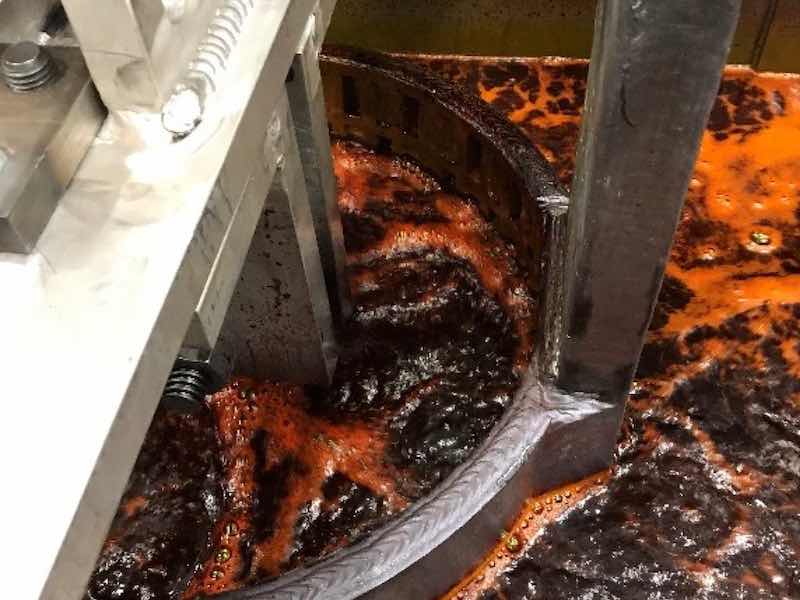Hard chromium plating bath chemistry has advanced through several stages since its introduction in the late 1920s.
A chromic acid solution will not provide a chromium deposit without the aid of a catalyst. The first successful catalyst used was the sulfate ion (SO4) at an ideal ratio of 100:1 to the amount of chromic acid in the bath. This process became known as the Sargent bath after its developer Dr. George Sargent, or simply the standard bath. It is still in limited use today.
 Eric Svenson Sr.Although the standard bath produces a suitable deposit, the process suffers several difficulties. The primary issue is the low efficiency, around 20%, which generates substantial cathodic gassing. The chrome misting generated is problematic to the health of the workers and to the environment. Another issue with the standard bath is the relatively wide crack structure and the negative effects of typical impurities build-up.
Eric Svenson Sr.Although the standard bath produces a suitable deposit, the process suffers several difficulties. The primary issue is the low efficiency, around 20%, which generates substantial cathodic gassing. The chrome misting generated is problematic to the health of the workers and to the environment. Another issue with the standard bath is the relatively wide crack structure and the negative effects of typical impurities build-up.
Advances to standard bath chemistry were all centered around making improvements to the type of catalyst used. Various fluoride compounds were introduced in the 1970s, which improved the plating efficiency, deposit hardness, and micro-crack structure but also increased cathodic etching in unplated areas.
In the 1990s, various sulfonic acid compounds were introduced to replace fluoride. This development improved the plating efficiency somewhat and eliminated the cathodic etching issue while still maintaining a good micro-crack structure, deposit hardness, and wearability. Both the fluoride and sulfonic acid ions worked in conjunction with the sulfate, although typically at a different ratio, to promote chromium’s deposition.
The primary purpose of developing a higher-efficiency catalyst system was to reduce the amount of chrome mist generated.
Today we refer to the fluoride and sulfonic acid ions as secondary catalysts, with sulfate still being the primary catalyst. A wide majority of the hard chrome baths in use today are of this dual-catalyst type. They perform quite well with one exception, which is what caused the air discharge regulations for chromium to be tightened.
Although the dual catalyst bath improved plating efficiency, it still generates a considerable amount of chrome misting. The misting volume is high enough that it can overload the ventilation system’s ability to remove chrome from the airstream before its discharge to the environment. This created dangers to both the public’s health and worker safety.
The chrome misting issue also causes significant problems with keeping the shop and the equipment clean.
To overcome this deficiency, many hard chrome platers used PFOS-based fume suppressants to supplement their ventilation system. However, this greatly increased their operating expense because fume suppressants are expensive and need constant replacement. PFOS has since been banned as being an overly dangerous forever chemical. Chrome misting is again the primary culprit for the renewed environmental attack on chromic acid.
Technical Development
Plating Resources, Inc. launched a research program in 2019 to develop a more efficient hexavalent hard chrome process and solve the chrome misting issue. This was accomplished using a dual approach toward Sustainable Hard Chrome Plating
- Developing a higher efficiency chrome catalyst system.
- Making design improvements to the equipment used.
The primary purpose of developing a higher-efficiency catalyst system was to reduce the amount of chrome mist generated. Side benefits include a slightly higher plating rate and a bath with increased impurity tolerance. The development proved successful and resulted in a triple-catalyst system consisting of two catalysts and a buffer working in conjunction with the sulfate ion (SO4), but this ion is derived from a paramagnetic compound that replaces sulfuric acid as its source.
It has now been demonstrated that Zero Cr emissions are possible while still using a hexavalent chrome process.
The next step in this development was to re-engineer some of the equipment components used to make the overall process (the bath and the equipment) more efficient. To be effective, the plating bath and the equipment need to work together in lowering chrome misting and, therefore, the overall emissions. The equipment modifications included the plating tank, agitation system, anodes, bussing, rinse operation, containment, and ventilation system. As a side note, automatic wash-down of the ventilation system is not needed, which reduces the daily volume of rinsate solution required.
Process Verification
This effect of this development was recently proven using a full-scale hard chrome operation plating at 20,000 DC amperes. The result after eight hours of operation at full amperage was Zero Chrome Discharge from the ventilation stack, no liquid chrome waste to treat, and the operators testing between 55-155 times below OSHA’s PEL.
Also, the equipment and the shop stayed clean of chrome mist build-up. All this was accomplished without the operators having to wear protective equipment or use a fume suppressant.
It has now been demonstrated that Zero Cr emissions are possible while still using a hexavalent chrome process. This is good news for the hard chrome industry because regardless of what the regulators intend, they can never lower the chrome discharge limit to below zero. With the right equipment, platers can stop using fume suppressants which provides considerable operational cost savings.
Hopefully, this development will open the eyes of the regulators and curtail their attack on hexavalent chrome, either by further restricting or ultimately banning its use altogether. A better application of their resources would be to assist the plating industry in adopting these newer technologies.
Efforts to improve the existing hard chrome industry are vital to America’s future. There is no suitable replacement for hexavalent hard chrome for many critical applications like aircraft, defense, and hydraulics. It’s also widely used in almost every American industry. Our economy, national security, and sovereignty all depend on a viable hard chrome industry.
Contact the author at PlatingResources@Yahoo.com for further information, and visit www.Plating.com



































